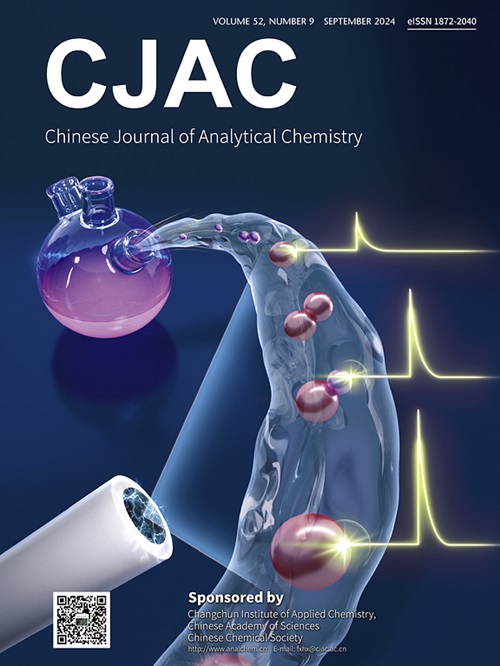Screening of urate-lowering components in TongFengTangSan using an integrated strategy of affinity ultrafiltration, molecular docking and in vitro validation
IF 1.3
4区 化学
Q4 CHEMISTRY, ANALYTICAL
引用次数: 0
Abstract
Hyperuricemia arises from an imbalance between uric acid production and excretion, resulting in elevated systemic uric acid levels. Consequently, therapeutic strategies targeting both production and excretion pathways offer a promising approach for managing hyperuricemia. TongFengTangSan (TFTS) has been frequently utilized as the Tibetan prescription in treating hyperuricemia or gout, and its anti-hyperuricemia effect has been confirmed in our previous study. However, the urate-lowering components still remain unclear. Therefore, an integrative strategy was constructed to screen potential urate-lowering components from TFTS by combination with affinity ultrafiltration, molecular docking and in vitro validation. In the present study, the main active fraction of TFTS with xanthine oxidase inhibitory effect was screened out by xanthine oxidase inhibitory assay. The potential ligands in main active fraction were identified by affinity ultrafiltration experiment combined with enzyme channel blocking technology and explored by ultra-high performance liquid chromatography-linear ion trap-Orbitrap mass spectrometry. Then, the screened ligands were further validated by in vitro xanthine oxidase inhibitory assay and molecular docking technique. Furthermore, the regulation effect on uric acid transporters of xanthine oxidase inhibitors was further evaluated by the over-expression of uric acid transporters in uric acid stimulated human Kidney-2 cell model by Western blot assay. In this study, the 60% ethanol-eluted fraction from the ethanol extract of TFTS was confirmed as the main fraction of TFTS with the best xanthine oxidase inhibitory effect. Three potential xanthine oxidase inhibitors were screened out from the 60% ethanol-eluted fraction, including 1,3,6-trigalloylglucose, 1,2,3,6-tetragalloylglucose and 1,2,3,4,6-pentagalloylglucose. Half maximal inhibitory concentration values of 1,3,6-trigalloylglucose, 1,2,3,6-tetragalloylglucose and 1,2,3,4,6-pentagalloylglucose for xanthine oxidase were 54.46, 15.91, 6.58 μg/mL, respectively. 1,3,6-trigalloylglucose, 1,2,3,6-tetragalloylglucose and 1,2,3,4,6-pentagalloylglucose were identified as mixed-type xanthine oxidase inhibitors. Additionally, these compounds demonstrated inhibitory effects on urate transporters 1 and glucose transporter 9. The combination strategy is suitable for screening active components with dual properties of inhibiting uric acid production and promoting uric acid excretion. 1,3,6-trigalloylglucose, 1,2,3,6-tetragalloylglucose and 1,2,3,4,6-pentagalloylglucose were identified as a potential urate-lowering drug and exhibited dual-target characteristics in uric acid metabolism.

亲和超滤、分子对接和体外验证相结合筛选通风汤散中降尿酸成分
高尿酸血症是由尿酸产生和排泄失衡引起的,导致全身尿酸水平升高。因此,针对生产和排泄途径的治疗策略为治疗高尿酸血症提供了一种有希望的方法。痛风汤散是治疗高尿酸血症或痛风的常用藏方,其抗高尿酸血症的作用已被我们的前期研究证实。然而,降低尿酸的成分仍然不清楚。为此,构建了亲和超滤、分子对接和体外验证相结合的综合策略,筛选TFTS中潜在的降尿酸成分。本研究通过黄嘌呤氧化酶抑制实验筛选出具有黄嘌呤氧化酶抑制作用的黄芪多糖主要活性部位。采用亲和超滤实验结合酶通道阻断技术鉴定了主要活性部位的潜在配体,并采用超高效液相色谱-线性离子阱-轨道阱质谱法对其进行了探索。然后,通过体外黄嘌呤氧化酶抑制实验和分子对接技术进一步验证筛选到的配体。通过Western blot检测尿酸刺激人肾-2细胞模型中尿酸转运蛋白的过表达,进一步评价黄嘌呤氧化酶抑制剂对尿酸转运蛋白的调节作用。本研究确定了黄嘌呤氧化酶抑制效果最好的黄嘌呤氧化酶主要部位为黄嘌呤提取物60%乙醇洗脱部位。从60%乙醇洗脱的部分中筛选出3种潜在的黄嘌呤氧化酶抑制剂,分别为1,3,6-三烯基葡萄糖、1,2,3,6-四烯基葡萄糖和1,2,3,4,6-五烯基葡萄糖。1,3,6-三烯丙基葡萄糖、1,2,3,6-四烯丙基葡萄糖和1,2,3,4,6-五烯丙基葡萄糖对黄嘌呤氧化酶的半数最大抑制浓度分别为54.46、15.91、6.58 μg/mL。1,3,6-三烯丙基葡萄糖、1,2,3,6-四烯丙基葡萄糖和1,2,3,4,6-五烯丙基葡萄糖被鉴定为混合型黄嘌呤氧化酶抑制剂。此外,这些化合物对尿酸转运蛋白1和葡萄糖转运蛋白9有抑制作用。该组合策略适合筛选具有抑制尿酸生成和促进尿酸排泄双重特性的活性成分。1,3,6-三烯丙基葡萄糖、1,2,3,6-四烯丙基葡萄糖和1,2,3,4,6-五烯丙基葡萄糖被认为是一种潜在的降尿酸药物,在尿酸代谢中表现出双靶点特征。
本文章由计算机程序翻译,如有差异,请以英文原文为准。
求助全文
约1分钟内获得全文
求助全文
来源期刊
CiteScore
3.60
自引率
25.00%
发文量
17223
审稿时长
35 days
期刊介绍:
Chinese Journal of Analytical Chemistry(CJAC) is an academic journal of analytical chemistry established in 1972 and sponsored by the Chinese Chemical Society and Changchun Institute of Applied Chemistry, Chinese Academy of Sciences. Its objectives are to report the original scientific research achievements and review the recent development of analytical chemistry in all areas. The journal sets up 5 columns including Research Papers, Research Notes, Experimental Technique and Instrument, Review and Progress and Summary Accounts. The journal published monthly in Chinese language. A detailed abstract, keywords and the titles of figures and tables are provided in English, except column of Summary Accounts. Prof. Wang Erkang, an outstanding analytical chemist, academician of Chinese Academy of Sciences & Third World Academy of Sciences, holds the post of the Editor-in-chief.

 求助内容:
求助内容: 应助结果提醒方式:
应助结果提醒方式:


